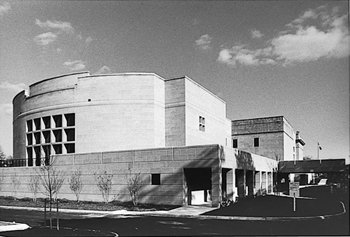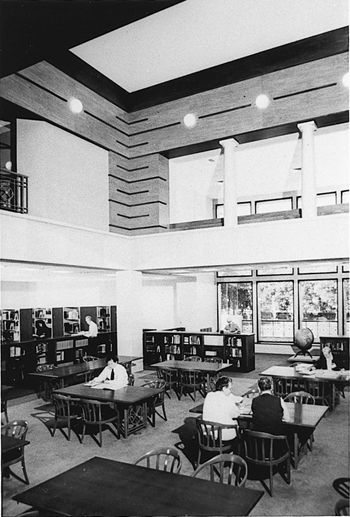MIDNIGHT IN THE GARDEN OF SOGGY AND DAMP: THE NEW YEAR'S EVE DISASTER AT THE VIRGINIA HISTORICAL SOCIETYSTACY RUSCH, & HOLLY HERRO
1 1. INTRODUCTIONThe Virginia Historical Society (VHS) in Richmond, established in 1831, is a privately endowed institution. Its collections survey Virginia history in the broadest sense and include books, manuscripts, portraits, photographs, furniture, objects, and ephemera. In June 1992, construction to double the size of the existing building was completed. The new addition included a conservation laboratory, a library, collections storage, exhibit space, a lecture hall, and offices (fig. 1).
On December 30, 1993, a fresh-air vent in the third-floor mechanical room at the society opened during the night, allowing the 8�F outside temperature to freeze a 1� in. fire-suppression pipe (fig. 2). The next day, New Year's Eve, the society was closed for the holiday. As the outside temperature rose, the pipe thawed, burst, and pumped approximately 300 gallons of water per minute into the building.
Fire alarms sounded when the water was released from the fire-suppression pipe at approximately 11:00 a.m. The outside security firm immediately received the alarm on its system and notified the fire department and the head of building and security, Steven Harrell, who was the key holder. The fire department arrived first on the scene and inspected the outside of the building for fire. Firefighters saw no evidence of fire and waited for a staff member to admit them to the building. Mr. Harrell arrived at 11:30 a.m. He entered the building with the firefighters and discovered the burst pipe. He cut off the water to the building, but by that time approximately 8,000 gallons of water had flooded the structure (fig. 3). Debris from the construction clogged the drains in the mechanical room, contributing to the overflow.
On the third floor in the manuscript storage room adjacent to the mechanical room, 40 boxes of unprocessed manuscripts, consisting of Virginia genealogical and business records, soaked up water because they were on the floor when the water gushed into the room from under the closed doors. The rare book storage area, directly below the mechanical room, was flooded by water that moved from the mechanical room through air handling vents and an elevator shaft. Water flowed out of the ceiling vents onto the rare books and broadsides in the rare book room, where it accumulated about 6 to 8 in. on the floor. Unfortunately, a deposited collection of rare European and American medical books, not owned by the society, sustained the majority of the water damage. Stonewall Jackson's bookcase, filled with his personal books, and an oversize paper globe housed in a Plexiglas case stored on the floor were also affected. The water flowing out of the rare book storage area wicked through the rug into the director's office and hallway, where John Marshall's desk, other antebellum furniture, four portraits by Charles Willson Peale, and a paper-and-ivory fan belonging to Evelyn Byrd were located. The first floor sustained the most damage. The water flowed down directly from the third floor because the center of the library's ceiling is a two-storied atrium encompassing the first and second floors of the building (fig. 4). Above is a catwalk with a 42 in. high wall along the top of atrium. The water from the mechanical room flowed into the catwalk and over the 42 in. walls, cascading down the four walls of the atrium over the reference collection, which was shelved around the perimeter. These materials sustained the most water damage of any items housed in the reading room. The water accumulated 4 in. deep in the reading room and an adjacent gallery. The collection of Virginia genealogical books did not get wet, but they were affected by the humidity. The ceiling of the area, where the microfilm reader-printers and microform materials were stored, was saturated with water, which caused most of the acoustical tile to fall. Portraits of Virginia notables grace the walls of the reading room, including Black Hawk by Robert Sully, Martha Washington by Rembrandt Peale, Patrick Henry by Thomas Sully, and Ellen Glasgow by Raymond Neilson. Busts, statuary, and models of ships were also housed in the reading room and were directly affected by the water. On the ground floor, water entered the general collection storage room from a large vent that was connected to the third-floor vent on the wall in the catwalk area. The books in the northwest corner of the building became wet on the edges.
|



